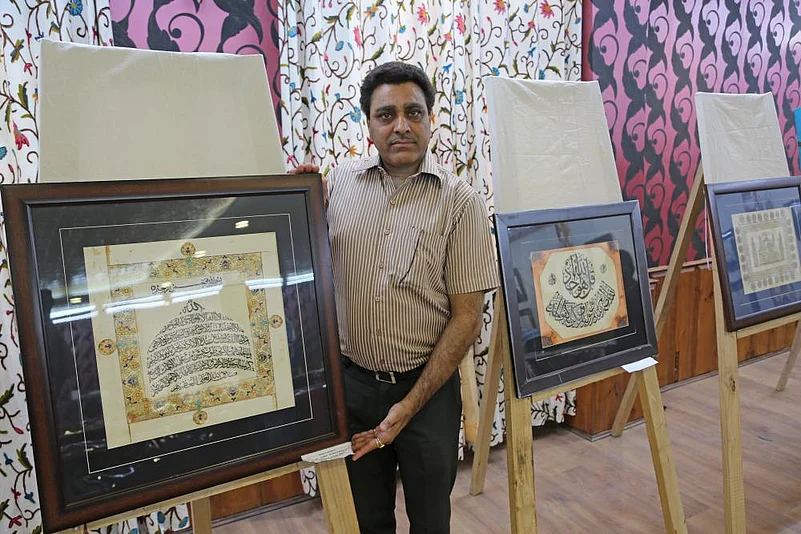More than seven decades ago, in pre-Independence India, little Mast Ram Abrol used to accompany his father to the palace of Hari Singh, who would end up to be the last Dogra ruler of Jammu and Kashmir. For, the senior Abrol was a jeweller at the court of the maharaja who remained the head of the princely state for 27 years till 1952, when the country abolished monarchy.
A good six-and-a-half decade thence, (late) Mast Ram’s sons continue with the Jammu family’s trade as jewellers, but then they are also into a denser cultural activity: collection of manuscripts of the Quran and Islamic calligraphy. A section of them are currently on display at an exhibition in Srinagar, much to the curiosity and admiration of the visitors at the Tourist Reception Centre in the state capital.
Mast Ram’s son Suresh Abrol says the manuscripts are part of what his grandfather Lala Rekhi Ram Abrol collected in his younger days. Back home, the family has turned one of their houses into a private museum displaying the artefacts. As scholars frequent the Abrols’ Jammu house for research, Suresh takes them around and gives them more information about the manuscripts and paintings besides ancient coins.
“It’s an interest that got passed on to us through our father,” winds back Suresh, in his mid-40s. “We too developed an interest in protecting the historical objects—and later began purchasing paintings, manuscripts, coins.”
Late Lala Rekhi Ram Abrol would collect coins of silver, gold and other manuscripts of different periods of the history and religions from people all across Jammu and Kashmir. “My father sought only one thing in his inheritance: these ancient manuscripts and other collections,” says Suresh. “We consider them our real inheritance.”
Suresh has two brothers—and they form a jeweller trio by profession, while looking after the collections. The siblings are being provided guidance by state ministry of culture to preserve and protect the collections. “Whatever requires for their preservation, we spend our own money on it. This is our passion,” says Suresh.
The family has 250 Quranic calligraphy collections and 130 of them are on the vellum, which is a unique type of paper used for arts and crafts and is made from goatskin or camel-skin. “If the vellum is thick, then it is of a camel-skin. If it is thin, it is of goatskin. We have got 40 vellum Quranic calligraphy collections here,” Suresh says.
The family has a laboratory also to take care of 5,000 manuscripts that are in Arabic, Persian, Sharda, Ayurveda and Sanskrit. A majority of them are on Ayurveda, the subcontinent’s ancient medical system with focus on overall welfare. “Whatever is in our home is sacred—whether it is the Quran, Bhagavad Gita or the Guru Granth Sahib,” says Suresh.
The family also has a series of Basohli and other paintings. The Basohli painting is northern India’s Pahari miniature painting that prospered in the hill states during the late 17th and the 18th centuries. They are known for their bold colour and line. They have also paintings of Guru Nanak Dev (1469-1539), the founder of Sikhism. “We are planning to showcase them in a glass-frame so as to ensure their longevity,” says Suresh.
On the display at Srinagar now are the Quran and also a genealogical tree of the Islamic prophets starting from Adam, the first human being on earth as per Islamic faith. “It is in gold,” reveals Suresh. “It was collected by my grandfather after paying certain ornaments to the seller.”
This is the first time that Abrol family has taken the collections out of their house and put them on display. “We did on a suggestion from the cultural department,” says Suresh. “It makes us so happy that a lot of people are coming to see them.”
















